Text
Discovering the Delight of Lettuce for Your Hamster: A Comprehensive Guide for Pet Owners
Let's Dive into the World of Lettuce and Hamsters!
Lettuce, with its crisp and refreshing taste, is a staple in many human diets. But can hamsters eat lettuce? The answer is yes, with a few considerations. In this ultimate guide, we'll explore the various aspects of including lettuce in your hamster's snacking routine.
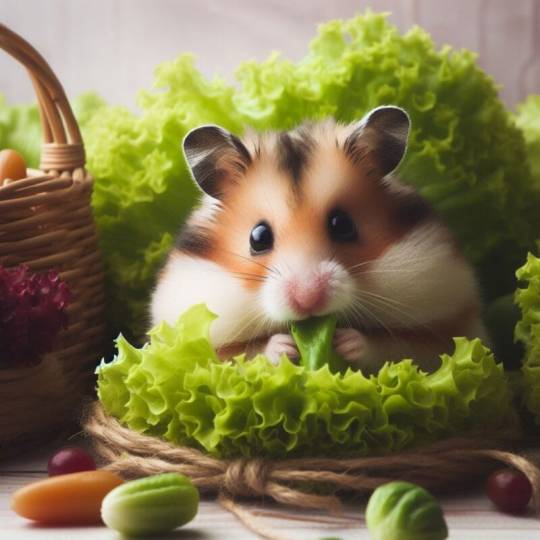
Understanding Lettuce Nutrition for Hamsters
Lettuce Overview: Lettuce is not just a leafy green; it's a nutrient-packed delight for your hamster. Rich in water, fiber, and essential vitamins like K, folate, and potassium, it offers a healthy addition to their diet. However, not all lettuce varieties are created equal. Romaine, green leaf, red leaf, and spring mix stand out for their superior nutritional value, while iceberg lettuce falls short due to its high water content.
Can Hamsters Eat Lettuce? The Answer is Yes, but with Nuances!
Choosing the Right Lettuce: Can hamsters eat lettuce? Absolutely! Opt for romaine, green leaf, red leaf, or spring mix for a dose of vitamins A, C, and K without excess water or risk. However, iceberg lettuce is a no-go due to its minimal nutritional benefits. Moderation is key – limit portions to 1-2 small leaves 2-3 times per week to keep your hamster's diet well-balanced.
Lettuce Benefits for Hamsters: The advantages of incorporating lettuce into your hamster's diet are noteworthy. From vitamin A for immune health to vitamin K supporting blood clotting, folate for cell growth, potassium for muscles and nerves, and the fiber aiding digestion, lettuce brings a bouquet of benefits.
Navigating Risks and Challenges
Lettuce Risks: While the benefits are clear, it's crucial to be aware of potential risks. Iceberg lettuce, with its high water content and minimal nutrients, can lead to diarrhea. Excessive lettuce consumption, regardless of the type, may result in loose stools and nutritional imbalances. Washing lettuce thoroughly is essential to remove pesticide residues and potential bacteria.
Symptoms of Lettuce Poisoning: Can hamster eat lettuce without risks? Keep an eye out for symptoms like diarrhea, lack of appetite, weight loss, lethargy, dehydration, muscle tremors, convulsions, and, in extreme cases, coma or death. The presence of E. coli, Salmonella, pesticides, or oxalates could be potential culprits.
Perfect Portions: How Much Lettuce is Just Right?
Portion Control: Can hamster eat lettuce in unlimited amounts? Not quite. Offer a measured portion of 1-2 small leaves 2-3 times per week. For different hamster breeds, tailor the quantity accordingly to avoid potential digestive issues. Remember, too much of a good thing can lead to diarrhea.
Syrian, Roborovski, Russian Dwarf, or Chinese Dwarf: Adjust the portion size based on your hamster's breed. For example, Syrian hamsters can enjoy 2 small leaves twice a week, while Russian Dwarf hamsters might do well with 1 small leaf torn into pieces 2-3 times a week.
Exploring Alternatives and Supplements
Variety is the Spice: Can hamster eat lettuce exclusively? While lettuce is a delightful addition, offer variety with alternatives like bok choy for calcium, carrot tops for vitamin A, arugula for vitamin K, cucumber for hydration, endive for fiber, bell pepper for vitamin C, and high-quality hamster foods like Oxbow Essentials and Supreme Petfoods Science Selective.
In Conclusion: A Leafy Adventure Awaits Your Hamster!
Embrace the Lettuce Experience: Can hamster eat lettuce? Absolutely, and with the right knowledge, it can be a joyful part of their diet. Just remember the key points – choose the right lettuce, control portions, watch for symptoms, and introduce variety for a well-rounded diet. Your hamster will thank you with happy squeaks and a healthy demeanor. Enjoy the journey of sharing wholesome lettuce snacks with your adorable furry friend!
0 notes
Text
Hamster and Broccoli: A Snacking Adventure for Caring Owners
Discovering the Delightful World of Broccoli for Your Furry Friend
As a devoted hamster lover, you want nothing but the best for your tiny companion. So, can hamsters eat broccoli? Let's embark on a hamster lover’s guide to safe and healthy snacking to find out!

Broccoli's Nutritional Bonanza for Hamsters
Broccoli, a cruciferous vegetable kin to cabbage and cauliflower, packs a nutritional punch for your hamster. Rich in vitamin C, vitamin K, folate, and fiber, broccoli is not just a treat for the taste buds but also a wholesome addition to your hamster's diet.
Navigating the Broccoli Dilemma: To Feed or Not to Feed?
The Green Light: Yes, your hamster can indulge in the goodness of broccoli, but moderation is key. The florets contribute essential vitamins, minerals, and fiber to your hamster's nutritional needs. However, too much of a good thing can sometimes lead to thyroid and digestive issues, so a cautious approach is advised.
Balancing Act: Broccoli, with its vitamin C, K, and folate, supports your hamster’s immune system and cellular metabolism. The carotenoids like lutein and zeaxanthin act as antioxidants, fighting off harmful molecules. The fiber content aids digestion, crucial for hamsters prone to gastrointestinal stasis. Yet, the presence of goitrogens requires careful monitoring of intake.
Benefits and Risks: Weighing the Broccoli Equation
On the Plus Side: Feeding broccoli to your hamster comes with several benefits, including immune system support, blood clotting aid, healthy digestion, new cell production, and antioxidant protection.
Watch Out for Detours: However, caution is necessary. Goitrogens in broccoli can disrupt thyroid function, excess fiber may lead to discomfort, and the vegetable's high water content could increase the risk of wet tail. Moreover, unwashed broccoli may harbor pesticides, posing a risk of poisoning.
Navigating the Broccoli Buffet: How Much is Just Right?
Portion Control: To ensure a healthy balance, limit broccoli to 2-3 times per week. Offer 1-2 small florets or leaves, each measuring up to 2 inches. This equates to 1-2 tablespoons of chopped broccoli per week. Stem consumption should be minimal due to its fibrous nature, as exceeding the recommended amount may result in thyroid issues or diarrhea.
Tailoring for Varieties: Adjust the broccoli servings based on your hamster's breed:
Exploring Alternatives and Supplements: A Culinary Adventure
Carrot Tops: A vitamin A-rich alternative
Basil: Providing antioxidants for an extra health boost
Cucumber: Ideal for hydration
Bell Peppers: A vitamin C-packed option
Cabbage: Contributing additional fiber
Strawberries: Offering a dose of vitamin C
Blueberries: Antioxidant-rich and flavorful
Choosing the Right Diet: Recommended Commercial Options
Mazuri Rat and Mouse Diet: A balanced commercial diet option
Supreme Petfoods Science Selective Hamster Food: A specially formulated hamster food choice
Oxbow Essentials Hamster and Gerbil Food: A well-rounded option for hamster nutrition
In the delightful journey of caring for your hamster, broccoli can indeed be a welcomed treat. With careful consideration of portions and variety, you're well on your way to providing a snacking adventure that keeps your furry friend happy and healthy. Happy snacking!
0 notes
Text
Sharing Insights on Hamsters and Onions: A Caring Guide
Curious about whether your hamster can munch on onions? Let's dive into the details, exploring the risks, safe alternatives, and a list of foods to avoid.

Getting to Know Onions
Onions, those bulbous vegetables packed with antioxidants, fiber, and nutrients, might be a staple in your kitchen. But when it comes to hamsters, can they safely indulge in these aromatic delights? The answer is a firm no. Onions contain compounds like disulfides and sulfoxides, which, when broken down, become toxic sulfur compounds.
The Big Question: Can Hamsters Eat Onions?
The verdict is clear: hamsters should steer clear of onions. Whether raw or cooked, the compounds in onions can harm a hamster's red blood cells, leading to a dangerous condition known as hemolytic anemia. Even in small amounts, onions pose a risk, and this caution extends to varieties like shallots, scallions, leeks, garlic, and chives.
Benefits? Not for Hamsters!
Are there any benefits to feeding onions to hamsters? Unfortunately, no. The minimal nutrients in onions don't outweigh the potential dangers of toxicosis. For optimal health, hamsters should rely on a balanced, commercially formulated hamster diet, along with safe fruits and veggies.
Understanding the Risks
Feeding onions to hamsters introduces compounds like N-propyl disulfide and thiosulfate, which can wreak havoc on oxygen transport in their red blood cells. The result? Hemolytic anemia, a potentially fatal condition. Keep an eye out for symptoms like lethargy, weakness, rapid breathing, pale gums, dark urine, and jaundice.
Recognizing Onion Poisoning Symptoms
If you suspect onion poisoning, act swiftly. Symptoms may manifest within 1-4 days and can include lethargy, loss of appetite, weakness, pale gums, rapid breathing, jaundice, and more. Immediate cessation of onion consumption and a call to the vet are crucial for prompt treatment.
How Much is Too Much?
When it comes to onions, any amount is too much for hamsters. Even tiny portions, powdered onion, or cooked variations can be toxic over time. It's best to completely eliminate onions and garlic, including any leftovers, from your hamster's diet. Stick to a quality pellet diet and consider introducing safe alternatives like carrot, cucumber, lettuce, apple, or banana. And, of course, consulting with an exotic vet before incorporating people foods is always a wise move.
Exploring Safe Alternatives and Supplements
When it comes to leafy greens and quality hamster food, there are plenty of alternatives to ensure your furry friend stays healthy:
Leafy Greens:
Quality Hamster Food Brands:
In Conclusion
When it comes to your hamster's well-being, it's essential to be mindful of their diet. By steering clear of onions and introducing safe, nutritious alternatives, you're ensuring a happy and healthy life for your furry companion. Share this insight with fellow hamster enthusiasts, and let's keep our tiny friends thriving!
0 notes
Text
Sharing the Sweetness: Exploring Pineapple Delights for Hamsters
Come along as we dive into the delightful world of pineapples, the tropical treat loved by humans for its sweetness and nutritional goodness. But the burning question remains: Can Hamsters Eat Pineapple? Let's unravel the juicy details and find out if our furry friends can enjoy this delectable fruit in moderation.
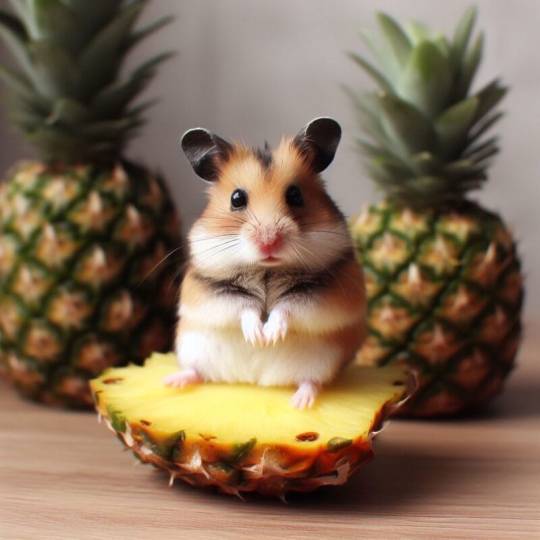
Getting to Know Pineapple
Pineapple, a delightful blend of fiber, vitamins, minerals, and antioxidants, is a tropical treasure trove of nutrition. Laden with vitamin C, manganese, copper, potassium, and other essential nutrients, this low-fat, cholesterol-free fruit is a fiber-rich delight.
Can Hamsters Delight in Pineapple?
Wondering, Can Hamsters Eat Pineapple? The answer is a cautious yes! In small quantities, fresh pineapple can be a delightful occasional treat for hamsters. Packed with natural sugars and beneficial fiber and vitamins, pineapple adds a dash of health benefits to their diet. However, moderation is key, given the high sugar content that might unsettle their sensitive digestive systems.
Benefits of Pineapple for Hamsters
Feeding Pineapple to hamsters unlocks a trove of health benefits:
Navigating Pineapple Risks
While the benefits are sweet, too much pineapple comes with its set of risks for hamsters:
Symptoms of Pineapple Overindulgence
Watch out for signs of pineapple overindulgence in hamsters, including:
Portion Control and Preventive Measures
Can Hamsters Eat Pineapple without worries? Yes, with careful consideration:
Exploring Alternatives and Supplements
For a well-rounded hamster menu, consider other fruits in moderation:
Top-notch hamster food brands to consider include:
In summary, the journey of Can Hamsters Eat Pineapple leads us to a cautious yet delightful yes. With careful moderation, this tropical treat can add a dash of sweetness to our hamsters' lives, keeping them happy, healthy, and ready for more adventures.
0 notes
Text
Sharing Hamster Care Wisdom: The No-Chocolate Rule!
Hey fellow hamster enthusiasts! Wondering if your tiny friend can indulge in some chocolatey goodness? Let's chat about the hamster-chocolate relationship and why it's a strict no-no for our furry pals.

Introducing the Chocolate Tale
Chocolate, that delectable treat from cacao seeds, is packed with antioxidants known as flavonoids. But here's the catch – it's also loaded with fat, sugar, theobromine, and caffeine. While these might not faze us, they can spell trouble for our hamster buddies.
Can Hamsters Eat Chocolate? The Clear Answer
Drumroll, please! Nope, hamsters should steer clear of chocolate. Whether it's dark, milk, or any other tempting form, chocolate houses the toxic duo – theobromine and caffeine – a combo that could be downright fatal for our hamster friends, even in small doses.
So, while we humans might cherish the occasional chocolate fix, our hamsters should never nibble on this sweet delight. It's a strict chocolate-free zone for them.
Risks of the Choco-Adventure
Why the fuss, you ask? Chocolate brings a hamster a host of problems:
Theobromine messes with the nervous system and heart rate.
Caffeine acts like a hamster-sized energy drink, causing rapid breathing and heart rate.
High fat and sugar pave the way for obesity, diabetes, and liver issues.
Milk chocolate comes with lactose levels that can stir up digestive troubles.
In a nutshell, chocolate is a recipe for disaster in hamster health.
Detecting Chocolate Poisoning Signs
If your little buddy has taken a secret chocolate nibble, watch out for signs like vomiting, diarrhea, loss of appetite, hyperactivity, seizures, or worse – coma and death. It's a hamster emergency!
Chocolate Consumption for Hamsters: Just Say No
Zero, zilch, nada! Hamsters should never taste chocolate. Even a tiny nibble could lead to theobromine poisoning. Chocolate offers nothing beneficial to a hamster's well-being.
Healthy Treat Alternatives: Let's Go Yummy and Safe!
Instead of tempting fate with chocolate, treat your hamster to safer snacks like carrot sticks, apple slices, blueberries, plain Cheerios, unsalted nuts, seeds, hay pellets, or crackers. And for a well-rounded diet, consider quality commercial options like Oxbow Essentials Regal Rat, Supreme Petfoods Science Selective Rat Food, or Mazuri Rat and Mouse Diet.
Can Hamsters Eat Chocolate? Final Verdict
The bottom line is crystal clear – chocolate is a big no-no for our hamster pals. Let's stick to treats that keep their tails wagging without any health hazards. Share this wisdom with your fellow hamster lovers!
0 notes
Text
Exploring Hamster Nutrition: Calendula Unveiled
Delving into the world of hamster care, the question arises – Can Hamsters Eat Calendula? Let's embark on a detailed journey into the benefits and cautions surrounding this vibrant flower in the hamster diet.
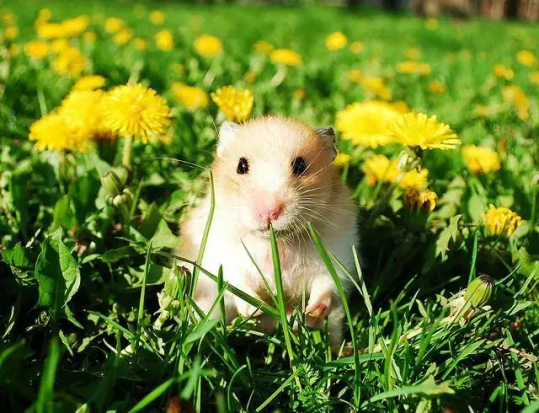
Introducing Calendula: Nature's Golden Beauty
Calendula, adorned with its sunny and vibrant petals, graces gardens and herbal remedies alike. The allure of this flower prompts the query – Is it a suitable treat for our hamster companions?
What Is Calendula Made Of?
Composed of carotenoids, flavonoids, and essential oils, Calendula, also known as marigold, boasts a unique combination of compounds contributing to its distinct qualities.
Nutritional Composition in Calendula: A Herbal Marvel
Calendula flowers, while not primarily consumed for nutritional content, are known for potential health benefits in herbal remedies.
Can Hamsters Eat Calendula? Unveiling the Truth
Yes, hamsters can indulge in the petals of calendula, provided they are organic and free from pesticides. Let's explore the reasons behind this affirmative answer.
Why Can Hamsters Eat Calendula in Moderation?
Calendula petals, non-toxic and safe in moderation, offer potential benefits such as sensory enrichment, possible anti-inflammatory properties, and the introduction of exciting natural flavors to your hamster's diet.
Benefits of Feeding Calendula to Hamsters: A Floral Delight
Enrichment: Calendula petals stimulate sensory exploration, fostering engagement.
Potential Health Benefits: Some herbal traditions suggest anti-inflammatory and soothing properties.
Natural Flavors: Introducing diverse flavors enhances mealtime excitement for hamsters.
Risks of Feeding Calendula to Hamsters: Considerations
While generally safe, a few considerations include ensuring the source is organic and offering calendula petals in moderation to avoid overfeeding or nutrient displacement.
What if Hamsters Eat Too Much Calendula?
Excessive consumption, like any food, can lead to imbalanced diets and potential digestive upset. Maintaining variety while adhering to appropriate portions is key.
Symptoms of Calendula Poisoning in Hamsters: A Cautionary Note
While rare, potential signs of excess ingestion include digestive distress, lethargy, and, in rare cases, allergic reactions.
How Much Calendula Can You Give a Hamster?
Offering a small piece or a few petals sporadically strikes the right balance between variety and a regular diet, ensuring a safe treat.
Alternatives and Supplements: A Nutritional Palette
Considering alternatives, chamomile, dandelion leaves, and parsley can provide nutritious variety in moderation, enhancing your hamster's culinary experience.
0 notes
Text
Exploring Chicken as a Treat for Your Hamster
Hey fellow hamster enthusiasts! 🐹 Wondering if your furry friend can munch on chicken? Let's dive into the world of hamster dining and find out if chicken is a healthy choice for these little cuties.
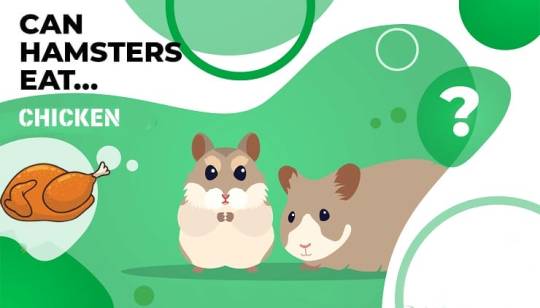
Introducing Chicken to Hamsters
So, what's the deal with chicken? Well, chicken is the meat derived from domesticated fowl and comes packed with protein, some fat, iron, magnesium, B vitamins, and a dash of vitamins A and D. But, can hamsters eat chicken? Let's spill the kibble!
Can Hamsters Eat Chicken? Absolutely!
Yes, indeed! Plain, cooked chicken can be a delightful addition to your hamster's menu. It brings in lean protein, essential vitamins, and minerals, giving your hamster a well-rounded nutritional boost. But, here's the golden rule – keep it plain! No oils, spices, or fancy seasonings. Hamsters have sensitive tummies, so let's keep it simple.
Benefits of Adding Chicken to Your Hamster's Diet
Why should you consider treating your hamster to a bit of chicken?
Risks to Watch Out For
Of course, with great treats come great responsibilities! Here are some risks to keep in mind:
How Much Chicken Can Your Hamster Enjoy?
Moderation is the key to a happy hamster tummy! Only serve a small portion of cooked, plain chicken breast meat two to three times a week. And hey, remember to adjust the serving sizes based on your hamster's breed:
Watch for Allergic Signs
Is your hamster turning into a chicken connoisseur or developing an allergy? Keep an eye out for signs like diarrhea, decreased appetite, itchy skin, or sneezing. If any of these symptoms pop up, give your vet a shout and halt the chicken treats.
Healthy Alternatives and Balanced Diets
Mix it up a bit! Besides chicken, your hamster can enjoy other safe meats like turkey, beef, fish, shrimp, crickets, or mealworms. Don't forget to explore quality commercial diets like Oxbow Essentials Adult Hamster Food, Mazuri Rat and Mouse Diet, or Supreme Petfoods Science Selective Hamster Food for a well-rounded nutritional feast.
Ready to treat your hamster to a culinary adventure? Share your hamster's favorite treats and let's exchange some adorable hamster dining stories!
0 notes
Text
Navigating Avocado Consumption for Hamsters
Avocado, a luscious fruit with creamy green flesh, is renowned for its rich flavor and nutritional benefits. But can hamsters eat avocado? Let's delve into the details to understand the dos and don'ts of incorporating this fruit into your hamster's diet.
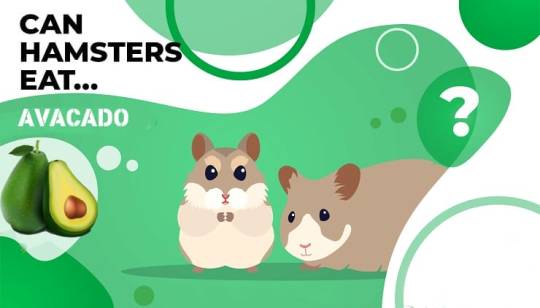
Introduction to Avocado: A Nutrient Powerhouse
Avocados are packed with healthy fats, fiber, vitamin K, folate, vitamin C, and potassium. Despite their nutritional richness, it's essential to note that avocados are relatively high in fat and calories compared to other fruits.
Can Hamsters Eat Avocado? A Moderated Affirmative
Yes, hamsters can indulge in avocado, but moderation is key. The creamy flesh harbors beneficial nutrients, but caution is warranted. Exclude the outer skin and pit, as they contain persin, a substance toxic to rodents.
Navigating Avocado Consumption for Hamsters: The Balance
While the nutritional profile of avocado is enticing, its high fat content designates it as an occasional treat for hamsters. Excessive consumption may pave the way for obesity and other health complications. Introduce avocado slowly, and diligently monitor your pet's weight to ensure a balanced diet.
Benefits of Avocado for Hamsters: A Nutritional Boost
Feeding avocado in measured amounts can offer several advantages:
Risks of Avocado Consumption: A Cautionary Note
While the flesh is generally safe in moderation, potential risks include:
Can Hamsters Eat Avocado? Monitoring and Prevention
To prevent adverse effects, adhere to these guidelines:
Symptoms of Avocado Poisoning: Identifying Red Flags
If you observe signs of avocado toxicity, such as vomiting, diarrhea, or respiratory distress, swift veterinary intervention is crucial. Persin toxicity can have a poor prognosis if not promptly addressed.
Recommended Avocado Consumption Limits: Tailoring to Hamster Types
For dwarf hamsters, offer a thin slice once or twice per month. Syrian hamsters can enjoy 2-3 thin slices once or twice per month. Always prepare fresh servings and adjust quantities based on your hamster's reactions.
Healthy Alternatives and Balanced Diets: Ensuring Hamster Well-being
Opt for safe fruits like apple, pear, banana, blueberries, cucumber, melon, peaches, and raspberries. Quality commercial hamster diets such as Oxbow Fortified Essentials, Mazuri Rat and Mouse Diet, and Kaytee Forti-Diet Pro Health provide balanced nutrition.
In conclusion, while avocado can be a flavorful addition to your hamster's diet, mindful and measured consumption is imperative to safeguard their well-being.
0 notes
Text
Small Bites, Big Questions: Can Hamsters Eat Cherries?
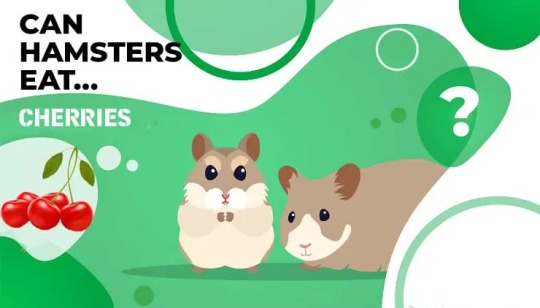
Introduction to Cherries
Cherries, beyond their sweet or tart taste, pack a nutritional punch for both humans and pets. Rich in fiber, vitamins C and K, potassium, calcium, and anthocyanins (antioxidants providing the red pigment), cherries offer a low-calorie, high-nutrient addition to our diets.
Can Hamsters Eat Cherries?
Yes, indeed! Hamsters can indulge in cherries, and both sweet and sour varieties are permissible. Cherries bring essential nutrients to their diet and introduce a flavorful variety. However, moderation is key, considering the high sugar content that can lead to issues like obesity and diabetes if consumed excessively.
Benefits of Feeding Cherries to Hamsters
Feeding cherries to hamsters, in moderation, can offer a range of benefits:
Vitamin C: Supports a robust immune system and aids in wound healing.
Anthocyanins: Act as antioxidants with anti-inflammatory effects.
Fiber: Promotes digestion and maintains regular gastrointestinal function.
Potassium: Supports proper muscle contractions and nerve transmissions.
Calcium: Contributes to the development of strong bones and teeth.
Risks of Feeding Cherries to Hamsters
While cherries are a nutritional boon, some risks need consideration:
High Sugar Content: Excessive consumption can lead to weight gain and blood sugar issues.
Allergies or Sensitivity: Some hamsters may be sensitive or allergic, resulting in diarrhea.
Choking Hazard: Cherries with pits pose a significant choking hazard and must be removed before feeding.
Sour Cherries: Higher sugar content may cause stomach upset in large amounts.
Symptoms of Cherry Poisoning in Hamsters
Excess consumption may lead to cherry poisoning, with symptoms including:
Digestive Upset: Diarrhea or soft stools.
Loss of Appetite: Refusal to eat.
Dehydration: Resulting from profuse diarrhea.
Lethargy and Weakness: From blood sugar changes.
Obesity: Over time due to excess sugar intake.
Recommended Cherry Consumption Limits
To ensure a healthy treat, cherries should be given as an occasional delight, not exceeding once or twice per week. Serving sizes vary based on hamster types:
Dwarf hamsters: One small slice or 2-3 tiny pieces at most.
Syrian hamsters: Two small slices or 3-4 small pieces at most.
Always monitor your hamster's response and adjust portions accordingly, ensuring pits are removed before feeding.
Healthy Alternatives and Supplements
For variety and balanced nutrition, consider healthy alternatives and quality commercial diets such as:
Fruits: Apple slices, blueberries, raspberries, banana, melon, pear, peaches.
Commercial Diets: Oxbow Essentials Adult Hamster Food, Kaytee Forti-Diet Pro Health Hamster Food, Supreme Petfoods Science Selective Hamster Food.
In navigating the question "Can Hamsters Eat Cherries?" the answer is affirmative, with due consideration for moderation and careful monitoring of your furry friend's well-being. Cherries can be a delightful addition to their diet when provided responsibly.
0 notes
Text
Can Hamsters Safely Enjoy Sprouts? A Guide to Incorporating Sprouts into Your Hamster's Diet
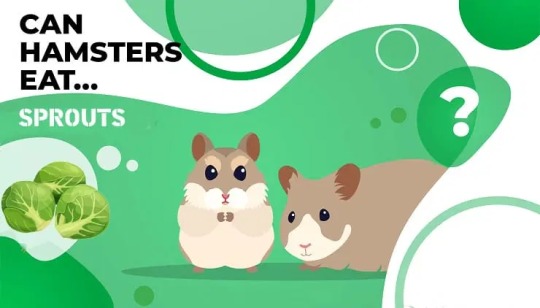
Benefits of Sprouts for Hamsters:
1. Vitamins: Boost immunity and cellular function with vitamin C, B-vitamins, and vitamin K.
2. Minerals: Support bone health, muscles, and metabolism with calcium, potassium, magnesium, and zinc.
3. Fiber: Aid digestion and dental health with the inclusion of dietary fiber.
4. Protein: Legume sprouts contribute plant-based proteins crucial for tissue maintenance and repair.
5. Antioxidants: Combat oxidative damage with the high antioxidant content found in sprouts.
6. Low Calorie: Prevent obesity with the low-calorie content of sprouts.
Risks of Sprouts for Hamsters:
1. Gas or Bloating: Introducing sprouts may cause flatulence due to their high fiber content.
2. Diarrhea: Transition slowly to avoid loose stools from excessive sprout fiber.
3. Contamination: Raw sprouts can harbor harmful bacteria like salmonella or E. coli if not properly cleaned.
4. Dehydration: Sprouts' low-calorie content may not fulfill hamsters' hydration needs.
Symptoms of Sprout Poisoning in Hamsters:
Keep an eye out for signs of sprout-related issues, such as diarrhea, lethargy, excessive gas, or reduced appetite. If any symptoms appear, discontinue feeding sprouts and consult your exotic vet promptly.
How Much Sprouts Can Hamsters Eat?
To maintain a balanced diet, feed hamsters 1-2 teaspoons of sprouts 2-3 times per week at most. Remove uneaten sprouts within 12 hours to ensure freshness.
For a well-rounded hamster diet, consider:
High-quality hamster pellets available at all times.
Unlimited timothy hay and chew toys.
Small daily portions of vegetables and fruits.
Occasional treats like hard-boiled egg whites.
Remember, sprouts should supplement, not replace, the main components of your hamster's diet.
Sprout Alternatives and Supplements:
Explore other produce options for a diverse diet:
Carrot: Rich in vitamin A and beta-carotene.
Cucumber: A hydrating option with antioxidants.
Cabbage: Contains vitamins C and K.
Bell pepper: Packed with vitamin C.
Broccoli: Provides fiber, vitamins C and K.
Apple: High in vitamin C and fiber.
Consider reputable hamster food brands like Oxbow Essentials, Supreme Tiny Friends Farm, Vitakraft VitaNature, Brown's Tropical Carnival, and Mazuri Rat and Mouse Diet.
In conclusion, with proper care and moderation, hamsters can safely enjoy the nutritional benefits of sprouts as part of their diverse diet.
0 notes
Text
Can Hamsters Eat Cereal? Navigating Safety and Nutrition

Can Hamsters Eat Cereal?
Yes, hamsters can consume small amounts of plain, low-sugar cereal in moderation. Opt for healthier options with whole grains and minimal added sugar. While a few oat rings or wheat squares can be acceptable treats on occasion, it's crucial to steer clear of cereals with artificial colors or flavors.
The crunchy texture and mild grain taste of cereals make them appealing to hamsters. However, to prevent overfeeding and obesity, it's important to limit portions. Choose healthy options and incorporate cereal sparingly into their diet.
Benefits of Cereal for Hamsters
Moderate consumption of plain, low-sugar cereals can offer hamsters several potential benefits:
Whole Grains: Provide complex carbs, fiber, and essential nutrients.
Low Sugar Content: Minimizes risks of obesity, diabetes, and digestive issues.
Crunchiness: Offers dental stimulation, aiding in wearing down teeth.
Protein: Some healthy cereals may contain added nuts, seeds, or legumes for plant-based protein.
Fortification: May include added vitamins and minerals like B-vitamins, iron, and calcium.
While a nutritious low-sugar cereal can give hamsters a crunchy texture and grain nutrition as an occasional treat, it should not become a dietary staple.
Risks of Cereal for Hamsters
However, regular or sugary cereals pose potential risks:
Obesity: High sugar content can lead to rapid weight gain.
Diabetes: Excess sugar exacerbates the risk of diabetes in hamsters.
Digestive Issues: Artificial flavors, sugars, and milk can cause diarrhea.
Nutritional Imbalance: Cereal should not replace balanced hamster food.
Choking Hazard: Some cereals may be too hard or large for tiny hamsters.
To mitigate these risks, limit cereal intake to only 1-2 pieces of healthy, low-sugar varieties a couple of times per week at most. Never feed sugary kids cereals.
Symptoms of Cereal Poisoning in Hamsters
Overfeeding cereal could lead to symptoms such as diarrhea, dehydration, obesity, lack of appetite, and tooth pain. If these signs appear, discontinue cereal and consult your exotic vet for appropriate treatment, which may include hydration, diet correction, and dental care.
How Much Cereal Can Hamsters Eat?
Limit hamsters to 1-2 small pieces of plain, low-sugar cereal like plain Cheerios or Wheat Chex a maximum of 2 times per week. Ensure a daily diet that includes high-quality hamster food, timothy hay, fruits, vegetables, and occasional treats. Cereal should only supplement their diet as a minimal treat, not a staple.
Cereal Alternatives and Supplements
For more treat variety, consider alternatives such as carrot, cucumber, apple, bell pepper, cooked egg white, and plain yogurt drops. Quality hamster food brands like Oxbow Essentials, Supreme Tiny Friends Farm, Vitakraft VitaNature, Brown’s Tropical Carnival, and Mazuri Rat and Mouse Diet are recommended for a balanced diet.
0 notes
Text
Hamster Nutrition 101: A Guide to Safely Introducing Walnuts
Introduction: Discover the secrets behind hamster nutrition in our guide to incorporating walnuts safely into your pint-sized companion's diet. Let's unravel the mystery and explore the delicate balance between indulgence and well-being.
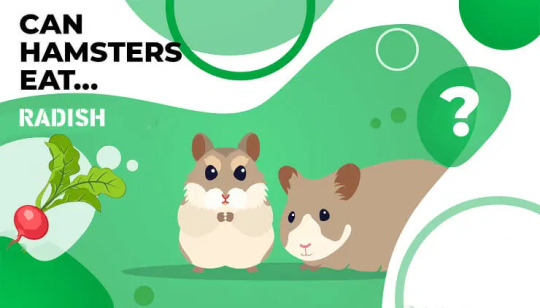
The Nutritional Goodness of Walnuts: Walnuts are a powerhouse of fatty acids, protein, fiber, vitamin E, copper, and manganese. These nutrients contribute significantly to your hamster's overall health, promoting muscle growth, skin health, metabolism, and more.
Moderation Matters: While hamsters can benefit from walnuts, moderation is crucial. Aim for 1-2 small walnut pieces 2-3 times a week to avoid issues like obesity, digestive discomfort, and potential allergies. Keeping portions in check ensures a well-balanced diet for your furry friend.
Why Walnuts are Hamster-Friendly:
Points to Ponder:
Detecting Walnut Overindulgence: Stay vigilant for signs like diarrhea, appetite changes, allergic reactions, and choking. Swift veterinary attention is crucial, involving dietary adjustments, medications, or allergy therapy.
Feeding with Finesse: Offer no more than 1-2 small walnut pieces 2-3 times weekly, removing uneaten bits within 12 hours to prevent spoilage. A well-rounded hamster diet includes premium pellets, hay, veggies, fruits, and occasional treats. Remember, walnuts should complement, not replace, the staples.
Alternatives and Additions: For treat variety, include carrot, apple, blueberries, cucumber, cooked egg white, and plain yogurt drops. Explore premium hamster food brands like Oxbow Essentials and Supreme Tiny Friends Farm for a diverse and nutritious menu.
Conclusion: In conclusion, walnuts can be a delightful addition to your hamster's diet with the right approach. Strike a balance between benefits and risks to ensure your furball enjoys a healthy and varied diet. By adding a mix of treats and maintaining a well-balanced feeding routine, you're contributing to your hamster's overall well-being.
0 notes
Text
Can Hamsters Eat Radish? A Complete Guide to Including Radishes in Your Hamster's Diet
Wondering, "Can Hamsters Eat Radish?" Radishes, part of the Brassica family, boast essential nutrients like vitamin C, potassium, folate, and antioxidants. In this comprehensive guide, we'll explore the benefits, risks, symptoms, and proper feeding guidelines to ensure your hamster enjoys radishes safely.
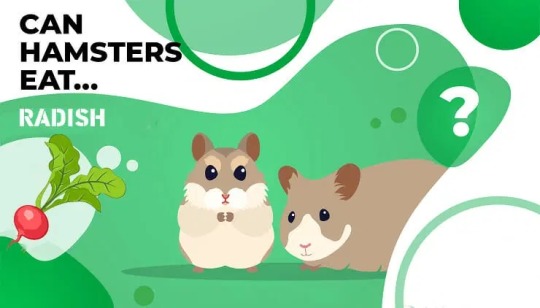
Can Hamsters Eat Radish? Understanding the Basics:
Radishes, both roots and leaves, offer nutritional value for hamsters. However, moderation is key to prevent digestive issues. Learn about introducing radishes gradually and providing small portions to maintain a healthy balance.
Benefits of Radish for Hamsters:
Discover the advantages radishes bring to your hamster's diet, from immune-boosting vitamin C to muscle-supporting potassium, fiber for digestion, folate for cell function, antioxidants, and hydration.
Risks Associated with Radish Consumption:
While radishes offer benefits, there are potential risks, including gas, diarrhea, allergies, pesticide residues, and choking hazards. We'll explore these risks and provide guidance on minimizing them through proper portion control.
Identifying Symptoms of Radish Poisoning:
Understand the signs of radish poisoning in hamsters, such as diarrhea, dehydration, bloating, loss of appetite, or lethargy. Learn when to discontinue radish feeding and seek veterinary attention.
Feeding Guidelines for Radishes:
Learn the optimal amount of radish to feed your hamster, emphasizing thin slices or torn leaves 2-3 times per week. Ensure you remove uneaten portions after 12 hours to maintain freshness.
Balanced Diet for Hamsters:
Discover the key components of a balanced hamster diet, including high-quality pellets, timothy hay, chew toys, fruits, and vegetables. Explore high-value treats and alternatives to radishes for a diverse and nutritious menu.
Alternatives and Supplements:
Explore alternative vegetables and supplements to provide variety in your hamster's diet. From carrots and broccoli to cucumber and bell peppers, discover nutritious options to complement radishes.
Recommended Hamster Food Brands:
Explore reputable hamster food brands that prioritize your pet's nutritional needs. Brands like Oxbow, Supreme Tiny Friends Farm, Brown's Tropical Carnival, Vitakraft, and Mazuri offer quality options for a well-rounded diet.
Conclusion:
With this guide, you're equipped to answer the question, "Can Hamsters Eat Radish?" Safely integrate radishes into your hamster's diet, considering both the benefits and potential risks. Remember, moderation, variety, and a balanced diet are key to ensuring your furry friend stays happy and healthy.
0 notes
Text
Can Hamsters Eat Peppers? A Comprehensive Guide to Safe Pepper Consumption
Can Hamsters Eat Peppers? The Nutritional Lowdown
Hamsters can safely indulge in both bell peppers and small amounts of chili peppers. Packed with vitamin C, antioxidants, and other essential nutrients, peppers make a healthy addition to a hamster's diet. Moderation is key to ensure your furry friend benefits without any adverse effects.

The Appeal of Peppers
The enticing crunch and vibrant colors of peppers make them an exciting and enjoyable treat for hamsters. While bell peppers offer excellent nutrition without spiciness, mild chili peppers can add a hint of spice if fed sparingly. In moderation, peppers contribute to a well-rounded hamster diet.
Benefits of Peppers for Hamsters
1. Vitamin C Boost: Peppers are rich in immune-supporting vitamin C, a vital component of a hamster's overall health.
2. Vision and Skin Support: With good levels of vitamin A, peppers contribute to improved vision and skin health in hamsters.
3. Potassium for Balance: Pepper potassium supports healthy blood pressure and fluid balance, crucial for a hamster's well-being.
4. Folate for Growth: Chili peppers, in particular, boast higher levels of folate, essential for cell function and tissue growth.
5. Dietary Fiber Aid: The skin of peppers provides digestion-aiding fiber, promoting a healthy digestive system in hamsters.
6. Antioxidant Power: Peppers contain antioxidants such as vitamin C, vitamin A, and carotenoids, further enhancing their nutritional value.
Risks of Peppers for Hamsters
While nutritious, excessive pepper consumption poses some risks:
Diarrhea: High water and fiber content may lead to loose stools if peppers are fed excessively.
Upset Stomach: The spiciness of chili peppers might cause temporary tummy upset.
Gas or Bloating: Bell peppers, especially when introduced newly, may cause flatulence.
Dehydration: The high water content in peppers increases fluid needs for hamsters.
To mitigate these risks, feed only small amounts of peppers occasionally, introduce new items slowly, and ensure a fresh water supply.
Symptoms of Pepper Poisoning in Hamsters
If hamsters consume an excessive amount of peppers, they may exhibit symptoms such as:
Diarrhea containing undigested pepper pieces
Dehydration from increased urination and fluid loss
Tummy pain or loss of appetite from spicy irritation
Gas and bloating if having difficulty digesting the peppers
If these symptoms persist, discontinue feeding peppers and consult with an exotic vet. Treatment may include hydration therapy, GI protectants, and dietary adjustments.
How Much Pepper Can Hamsters Eat?
Feed hamsters 1-2 small slices of bell pepper or a tiny nibble of mild chili pepper 2-3 times per week. Remove uneaten peppers within 12 hours. For a balanced diet, supplement with high-quality commercial hamster food, timothy hay, vegetables, fruits, occasional proteins, and other treats.
Alternatives and Supplements to Peppers
For produce variety, consider offering:
Carrots: Rich in vitamin A
Broccoli: Provides vitamin C
Squash: Contains vitamin A, C, magnesium
Sweet Potatoes: High in beta-carotene
Blueberries: Packed with antioxidants
Apple: Offers fiber and vitamin C
Cucumber: Helps hydration
Quality hamster food brands include:
Oxbow Essentials Adult Hamster & Gerbil Food
Supreme Tiny Friends Farm Reggie Rat and Mimi Mouse Food
Kaytee Forti Diet Pro Health Hamster Food
Vitakraft Menu Hamster Food Mix
Brown’s Tropical Carnival Daily Diet for Hamsters
Can Hamsters Eat Peppers? Absolutely, with the right balance, hamsters can enjoy the nutritional benefits of peppers as part of their diverse and healthy diet.
0 notes
Text
Can Hamsters Eat Cauliflower? Exploring the Safety of This Vegetable for Hamsters
Inquisitive about whether hamsters can enjoy cauliflower? This article delves into the safety of including this vegetable in your hamster's diet.
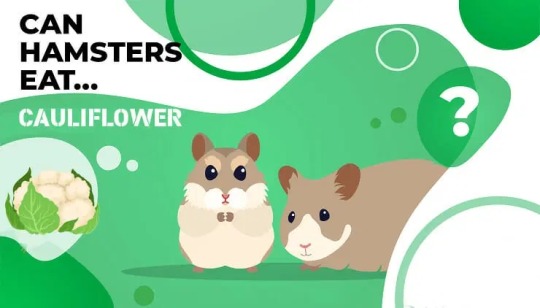
Can Hamsters Have Cauliflower?
Yes, hamsters can indulge in small amounts of cauliflower as an occasional treat. Despite being low in fat and calories, cauliflower packs a punch with fiber, vitamin C, vitamin K, and antioxidants. However, overfeeding may lead to gas and bloating.
Benefits of Cauliflower for Hamsters
Discover the advantages of feeding cauliflower to your hamster in moderation:
Vitamin C: Cauliflower boasts high levels of antioxidant vitamin C, promoting robust immune health.
Dietary Fiber: Rich in insoluble fiber, cauliflower supports healthy digestion in hamsters.
Vitamin K: Essential for proper blood clotting, cauliflower contributes to your hamster's vitamin K intake.
Antioxidants: Loaded with antioxidants such as vitamin C, manganese, and phytonutrients, cauliflower enhances overall well-being.
Hydration: The vegetable's high water content aids in keeping hamsters hydrated.
Risks of Cauliflower for Hamsters
While cauliflower offers benefits, there are potential risks associated with overconsumption:
Gas and bloating: Polysaccharides in cauliflower can cause flatulence in hamsters.
Diarrhea: Excessive fiber may result in loose stools.
Thyroid problems: Goitrogens in cauliflower may disrupt thyroid function if overfed.
Choking hazard: Cauliflower florets may pose a choking risk for small hamsters; consider cutting them into bite-sized pieces.
Symptoms of Cauliflower Poisoning in Hamsters
Eating too much cauliflower might lead to symptoms such as severe diarrhea, excessive gas, dehydration, or disinterest in food. If these occur, discontinue feeding cauliflower immediately and consult your exotic vet.
How Much Cauliflower Can Hamsters Eat?
Stick to 1-2 small florets or thin slices 2-3 times per week. Remove uneaten leftovers after 1-2 hours to prevent overfeeding.
A Balanced Diet for Hamsters
Ensure a balanced diet for your hamster by incorporating:
High-quality hamster pellets
Timothy hay and chew toys
Small daily portions of fruits and vegetables
Occasional proteins like boiled egg white or plain yogurt
Cauliflower should supplement, not replace, staple diet foods. Limit portions to prevent overfeeding.
Alternatives and Supplements
For variety, consider adding:
Carrot for vitamin A and beta-carotene
Cucumber for hydration and minerals
Bell Pepper for vitamin C and antioxidants
Broccoli for fiber, folate, vitamins C and K
Sweet Potato for vitamin A and potassium
Blueberries for antioxidants
Apple for fiber and vitamin C
Explore quality hamster food brands like Oxbow, Supreme, Vitakraft, Brown's Tropical Carnival, and Mazuri for a well-rounded diet.
0 notes
Text
Can Hamsters Eat Vegetables? A Guide to a Balanced Diet
Hamsters, as omnivores, require a balanced mix of plant and animal matter for optimal health. In this article, we explore the benefits and potential risks of incorporating vegetables into your hamster's diet, ensuring their well-being and nutrition.
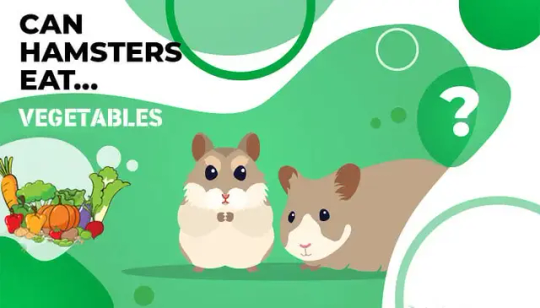
Benefits of Vegetables for Hamsters
Vegetables bring a wealth of nutrients essential for hamster health, such as vitamin C, vitamin K, potassium, calcium, and antioxidants. Including a variety of vegetables in your hamster's diet offers:
Vitamin C Support: Bell peppers, broccoli, and kale contribute to immune health.
Blood Clotting Aid: Leafy greens high in vitamin K aid in blood clotting.
Muscle and Nerve Function: Spinach, sweet potatoes, and broccoli provide essential potassium.
Digestion Support: The insoluble and soluble fiber in vegetables aids digestion.
Healthy Skin and Eyes: Carrots and sweet potatoes, rich in beta-carotene, promote skin and eye health.
Cell Growth and Reproduction: Spinach and turnip greens, high in folate, support cell growth.
Risks and Considerations
While vegetables offer numerous benefits, it's crucial to be aware of potential risks:
Diarrhea: Introduce vegetables slowly to avoid excessive fiber causing loose stools.
Gas or Bloating: Some vegetables may cause gassiness; introduce them gradually.
Choking Hazard: Chop hard vegetables into bite-sized pieces to prevent choking.
Pesticides: Choose organic vegetables when possible and wash produce thoroughly.
Oxalates: Limit high oxalate veggies like spinach to avoid blocking calcium absorption.
Symptoms of Vegetable Poisoning in Hamsters
Feeding excessive vegetables may lead to symptoms such as diarrhea, dehydration, tooth pain, bloating, or gas. If severe, consult your exotic vet for appropriate treatment.
How Much Vegetables Can Hamsters Eat?
A general guideline is to offer 1-2 teaspoons of chopped vegetables daily. Opt for small, manageable pieces of baby carrot, broccoli florets, cucumber slices, or sweet potato chunks.
For a balanced diet:
High-quality hamster pellets and hay should be available at all times.
Provide small daily amounts of vegetables and fruits.
Include insect protein like mealworms 2-3 times per week.
Consider occasional treats such as plain yogurt drops or seeds.
Vegetable Alternatives and Supplements
To add variety, consider offering:
Carrots for beta-carotene
Cucumber for hydration and antioxidants
Cabbage for vitamins C, K, and potassium
Bell peppers for a vitamin C boost
Turnip greens for calcium and vitamin K
Squash for vitamin A, C, and magnesium
Peas for protein, fiber, and vitamins
Green beans for nutrients like vitamin K, C, and folate
Quality Hamster Food Brands
Consider these reputable hamster food brands for a well-rounded diet:
Oxbow Essentials Adult Hamster & Gerbil Food
Mazuri Rat and Mouse Diet
Supreme Tiny Friends Farm Reggie Rat and Mimi Mouse Food
Brown’s Tropical Carnival Daily Diet for Hamsters
Vitakraft VitaNature Dwarf Hamster Food
In conclusion, a thoughtfully balanced diet, including a variety of vegetables, ensures your hamster's nutritional needs are met. Monitor their response to new foods and consult your vet for personalized advice. Providing a diverse and nutritious diet contributes to the overall well-being and happiness of your hamster.
0 notes
Text
Can Hamsters Eat Applesauce? A Sweet Treat or a Sticky Problem for Hamsters?
Applesauce, a smooth, creamy blend derived from cooked apples, raises the question: Can Hamsters Eat Applesauce? While it packs the nutritional goodness of apples, including vitamin C, vitamin A, potassium, and pectin, caution is warranted due to the prevalence of added sugars in many commercial varieties.

Can Hamsters Eat Applesauce?
Yes, hamsters can enjoy plain unsweetened applesauce in moderation. The soft, palatable form provides essential nutrients from apples, but its natural sugars dictate that it should remain an occasional treat rather than a dietary staple.
Benefits of Applesauce for Hamsters
Plain unsweetened applesauce offers hamsters several nutritional advantages, including:
Vitamin C: Supports immune health with antioxidant properties.
Dietary Fiber: Aids digestion through pectin and apple fiber content.
Vitamin A: Beta-carotene in apples converts into vitamin A.
B-vitamins: Small amounts aid in converting food into cellular energy.
Potassium: Supports normal blood pressure and nerve function.
Antioxidants: Polyphenol compounds act as antioxidants in the body.
Risks of Applesauce for Hamsters
Despite its benefits, excessive consumption of applesauce can pose health risks, such as:
Obesity: Natural sugars and calories may lead to weight gain.
Diabetes: Excess sugar intake worsens the risk of diabetes in hamsters.
Diarrhea: Too much fruit sugar and fiber may cause gastrointestinal upset.
Stickiness: Applesauce residue can lead to dental issues.
Dehydration: Despite its appearance, applesauce has low moisture content.
To mitigate these risks, feed tiny portions of unsweetened applesauce infrequently and ensure access to fresh water.
Symptoms of Applesauce Poisoning in Hamsters
Overconsumption of applesauce may manifest in symptoms like diarrhea, decreased appetite, lethargy, or tooth pain. If severe, consult your exotic vet for supportive care and discontinue applesauce.
How Much Applesauce Can Hamsters Eat?
Limit unsweetened applesauce to 1-2 teaspoons 2-3 times per week. A balanced hamster diet should include high-quality pellets, Timothy hay, fruits, vegetables, and occasional treats like cooked egg white, plain yogurt drops, and carrot.
Alternatives and Supplements to Applesauce
For variety, offer these foods in moderation:
Blueberries: Antioxidant-rich.
Banana: Provides potassium and magnesium.
Pear: High in fiber for digestion support.
Melon: Helps keep hamsters hydrated.
Carrot: Rich in beta-carotene.
Broccoli: Contains fiber, vitamin C, and antioxidants.
Sweet Potato: A good source of vitamin A.
Cucumber: Provides trace minerals and hydration.
Cooked egg white: Offers animal protein.
Quality hamster food brands include Oxbow Essentials, Supreme Tiny Friends Farm, Mazuri, Brown’s Tropical Carnival, and Vitakraft VitaNature.
0 notes